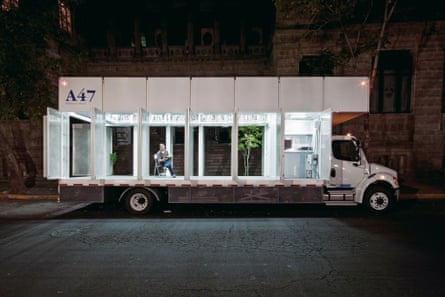Does your library arrive at your home on an elephant? Perhaps it floats down the river? Is it in your local telephone box, railway station – or even your back garden?
Librarians have a long history of overcoming geographic, economic and political challenges to bring the written word to an eager audience. They continue to live up to that reputation, despite the rapid and sweeping changes in how we read and share books in the 21st century.
Part of the change is architectural. Instead of the stately structure in the centre of town with which we are usually most familiar, your local library might now be anything from a pop-up to an imaginative architectural masterpiece resembling a shelf of books or the inside of an iceberg. The shift is also technological, reflecting the increased use of mobile apps and digital technology to bring books to a wired world, although many of the libraries in this book still rely on people lugging traditional print books around.

All these new nontraditional libraries offer far more than simple collections of books. Many function as community centres and assist their members in overcoming economic, social and geographical barriers. Others provide an unexpected dose of culture for commuters, beachgoers, cafe customers and even prisoners. All aim to make books more widely accessible and enjoyable than ever.
The vast majority of the smaller libraries in this book owe their existence to a single person, a librarian with an unstoppable vision. Hernando “Nanie” Guanlao has been running his personal public library, Reading Club 2000, for more than a decade in Manila in the Philippines. Originally set up to honour his parents’ memory, the initial stock of 100 books on the pavement outside his home has now grown to several thousands. Passers-by can borrow as many books as they want and bring them back whenever they feel like it. Or, indeed, just keep them.
Other libraries come into being to meet very specific needs, such as the “story tower” built by Latvian design students as a temporary replacement for a public library that had been closed for refurbishment, or the mobile libraries in Haiti that offer reading material to people around the country following the recent series of natural disasters.

Regardless of the ultimate fate of the printed book, reports of the imminent death of the library as a physical entity seem to have been greatly exaggerated. Bookless digital public libraries are already starting to appear, the first in San Antonio, Texas, where lines of bookshelves have been replaced by e-readers, computer workstations, laptops and tablets.
The simple truth is that, like Roald Dahl’s character Matilda, people like going to libraries. Indeed, going to the library is like getting a pay rise, according to a survey conducted in 2014 by the UK’s Department for Culture, Media and Sport. The survey, which attempted to quantify how happy different activities make us, showed that while dancing and swimming nearly always cheer us up, so does going to the library. The uplift it gives people is apparently equivalent to getting a £1,359 pay rise!
Improbable Libraries is published by Thames & Hudson (£14.95). Click here to buy it for £11.96

Comments (…)
Sign in or create your Guardian account to join the discussion